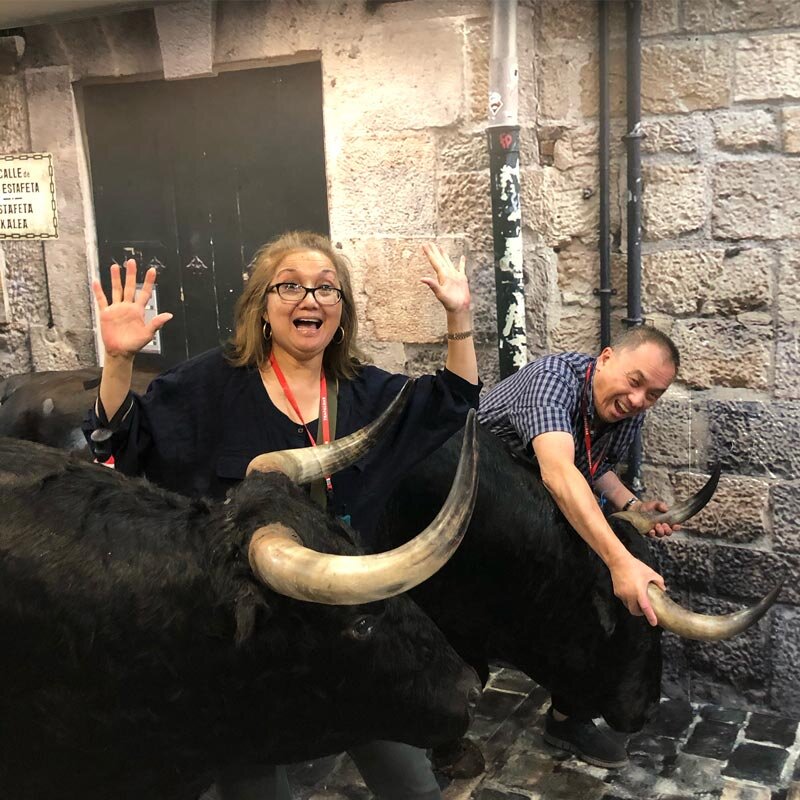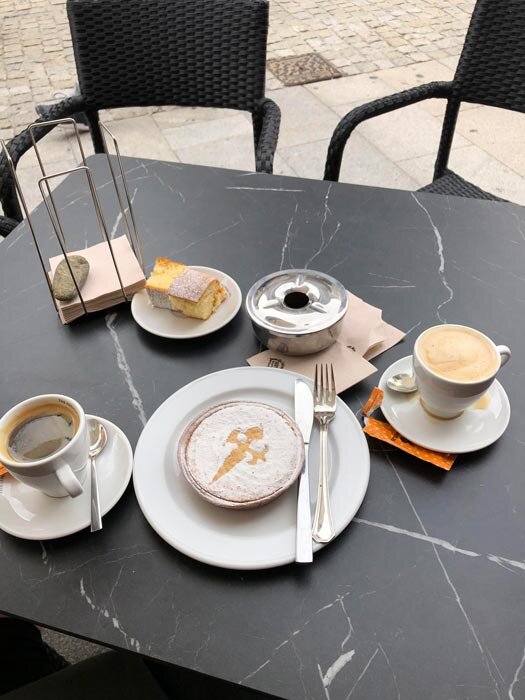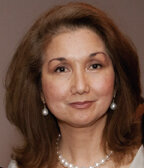Modern Pilgrims Find Each Other in Northern Spain
/Four centuries later, King Philip II’s brand lives on in businesses that may or may not have anything to do with the country named after him, such as this restaurant in Comillas. (Photo by Cherie M. Querol Moreno)
Some would argue that the Filipino diaspora is a consequence of racial inequality wrought by that colonization, which awarded progeny of conquistadors vast lands and trading posts, mingling DNAs on which to build careers where western attributes are deemed preferable.
But the Filipinos who call the south side of the Pyrenees home these days mostly represent the heirs of Mactan chieftain Lapulapu rather than his foreign adversaries. They’re the intrepid expatriates who uprooted from the homeland where jobs are scarce, especially for those with no connection to the establishment. Barcelona is a city where Pilipino can be heard on the streets, in restaurants and hotels, stores and offices, thanks to locals who have sewn themselves firmly and vibrantly into the city’s social tapestry.
However, the crisp Tagalog that pealed this time around on our arrival in modernista Gaudi’s city did not emanate from local residents, but from visitors who had flown from the archipelago to join our jaunt in the northern provinces.
They redefine that Positively Filipino favorite pastime, “pinoyspotting.”
Interestingly, Filipinos refer to each other as “kabayan” even though our passports are different. “Ka-lahi” seems more appropriate, if my Tagalog teacher Mrs. De Leon would approve.
For the first time since we began celebrating our wedding anniversary every autumn across the Pond, we found ourselves in the company of mostly Spanish-speaking people last month. From Cuba by way of Maryland, Virginia and Miami; the Dominican Republic via Harlem in New York; Honduras through San Diego; Puerto Rico via Tampa and directly from San Juan, inhabitants of former colonies gathered alongside Boston-born Germans; a Quebec-born Chinese San Franciscan and his “Spanish American” wife; a South Vietnamese from Santa Clara; Eastern Canadians and Aussies -- in our colorful bevy led by our tour director, whose mother is French Basque and father a Scot.
Teeny tiny planet, I often say.
“The crisp Tagalog that pealed this time around on our arrival in modernista Gaudi’s city did not emanate from local residents, but from visitors who had flown from the archipelago to join our jaunt in the northern provinces.”
Maybe we were simply a cohesive bunch, but we learned in no time that we had a retired NASA engineer, a certified public accountant, several techies, three teachers, three PhDs and at least three nurses and seven doctors of medicine on an 11-day journey from cosmopolitan Barcelona through the rugged provinces on the Atlantic shore and ending in the landlocked, sophisticated capital Madrid.
When Elvira, one of the Cuban exiles, replied to me in the customary “Si, mi amor” just days from our welcome reception, I knew this would be a fun tour. And while the adventure focused on less trodden but much-fabled towns, we found our fellow travelers equally fascinating.
Especially those from the Philippines.
Shy? Nope. Docile? Exactly the opposite. Underprivileged? Guess again. The trio from Southeast Asia crushed stereotypes often assigned to their origins.
“We’re from the Philippines!” Mavic Vasquez introduced herself, her husband Raf and former classmate Mariles Valte on Day 1. By Day 3, they were the stars of the group, Mavic and Mariles celebrating their birthdays one day apart and thus becoming objects of several toasts, serenades, and well wishes.
Philippines-based doctors Mavic and Raf Vasquez and Mariles Valte enjoy the breeze at Finisterre, the northernmost tip of Spain. (Photo by Cherie M. Querol Moreno)
They were traveling together on the first leg of their European voyage that would climax in Iceland, where, their fingers crossed, the aurora borealis would present itself. A few days in the City of Lights would follow, before the mega-mile flight back over the Pacific. To their day jobs.
Personal information is typically kept to a minimum in these organized tours, where boundaries are firmly established. It’s key to keeping everyone comfortable through several days packed in a luxury coach. Everyone is free to reach out and initiate conversation; but the unwritten rule is to avoid discussing politics and religion – the obvious hornets’ nests. Also paying close attention to body language: Monosyllabic responses probably translate to “leave me alone.”
So what school did you guys attend? The Californian broke the ice with the friendly Manilan.
“We were together in pre-med,” Valte replied after we marveled at the prehistoric art replicated in the cave of Altamira near Santillana del Mar.
You’re a doctor?
“We all are. He’s a surgeon,” she motioned toward Raf. “They own a hospital in Cavite.”
For someone with hands worthy of their own insurance coverage, Dr. Raf seemed pretty chill. In Iruña, as Basques call Pamplona, he called for a photo while poking his head between two planks in the corral that separates spectators from the daredevils who run with the bulls mid-July in nearby San Fermin, Navarra. On a foggy dinner cruise, he volunteered to pour the cava to warm us while our boat navigated the choppy Cantabrian waters. On another cruise, this time over the “fjords” and mollusk beds of Rias Baixas, Galicia, he jumped out of his seat to get down with our new Latino friends after munching on the freshest mussels downed with cold Albariño.
Author “runs” with the bulls in Pamplona. (Photo by Fran Sealey)
He held up the rear as we strolled majestic towns from Zamora to Salamanca, where we paused to look for the famed frog on the facade of the main building of the country’s oldest university. That’s how he stayed close to his missus, a pediatrician who liked to flit into stores and always came out with a nifty purchase. With his arm up as a mobile landmark, in case one of us got waylaid ogling trinkets galore,
Dr. Raf showed that Filipinos are not vertically challenged.
Hearing they were alums of the University of Santo Tomas, I established another commonality.
My grandfather was the first head of the College of Medicine, I disclosed to Dr. Mariles, who hardly heard, understandably preferring to seek espadrilles in San Sebastian to chatting about her departed predecessor, even if he was a WWII hero with a street named in his honor, having been executed by the invading Japanese Imperial Army for ministering to wounded guerrillas.
Mariles defines today’s Filipina: confident; independent; assertive; outspoken. She looks half her age.
If Martha of the Castañon Family Sidraderia knew the general practitioner’s age, she probably would not have sent Mariles squeezing into an empty barrel of apple cider to put an exclamation point on the latter’s birthday celebration in Villaviciosa, Asturias.
“The hardest part was getting out,” said Valte, who realized the value of weighing less than 100 pounds when she eventually managed to slither out of the receptacle.
Dr. Mariles Valte punctuates her birthday celebration with a full body visit inside a cider barrel in Asturias. (Photo by Cherie M. Querol Moreno)
We’d see her strolling outside the hotel in Santander, deciding what to do on an evening we were free to roam around the majestic Casino which, according to our travel director, was less gambling joint than the royals’ playground. She could guzzle a big glass of white wine and not get a migraine the following morning. She gave advice on how to layer up with high-tech underthings and keep warm when the weather turned -- to the North American.
Together we were pilgrims for many reasons, for a few days.
We knelt before the altars of at least ten churches including the Basilica of de Santa Maria Real de Covadonga on the site of the country’s first Christian kingdom after the Moorish conquest.
We unburdened ourselves of our worldly troubles – if symbolically -- at Santiago de Compostela, where the scallop-covered body of St. James supposedly washed up from the sea. The Old Town has been a pilgrimage site since the 9th Century, its cathedral the final destination and highlight of what is known as The Way of St. James or Camino de Santiago. To earn indulgences, pilgrims from all over the world trek from various routes starting in France, Portugal, or Spain.
Santiago (Spanish for St. James) de Compostela (field of stars) is quite the tourist magnet. Last year, close to half a million visited, some earning the “compostela,” a certificate for completion of The Way, which takes at least 100 km by foot or 200 km on a bike.
The remains of the patron saint of Spain are said to be buried underneath the apse, but scaffolding and crowds prevented us from eyeballing the tomb.
Instead, we feasted on samples of local confections proffered left and right throughout town: Caprichos or crisp cookies and Tarta de Santiago, both made from almonds. The latter is dusted with sugar to mark a cross, in case anyone forgot about the sanctity of the ground on which they stood. Scallops of every size and medium, mostly made in China, are proof of having passed through it.
Signature almond pastries are a reminder that Santiago de Compostela is sacred ground. (Photo by Cherie M. Querol Moreno)
Our search for local Filipinos ended at the foot of the Cathedral of Santiago de Compostela, where we crossed paths with a throng who looked like us and smiled back upon hearing the familiar “Kumusta!” They stopped in their tracks as if running into long-lost relatives, eager to exchange pleasantries in Tagalog. They were from Bilbao, they said, stating that one of them was a nurse soon as they learned of the three doctors from the Philippines, and bonding with the Filipinos from California.
Like us, they were wayfarers broadening their horizons, building consciousness while bridging cultures, making this planet a bit smaller.
San Francisco Bay Area–based Cherie M. Querol Moreno, MC74 Communication Arts, earned a 2019 Homecoming Triple A award for advocating for Filipino American empowerment as a journalist and promoting safe environments as founder-executive director of ALLICE Alliance for Community Empowerment. She received her award in spirit.
More articles from Cherie Querol Moreno







